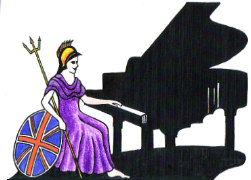Teachers, Accompanists and Piano Entertainers in the UK

UK Piano Page

Browse Locations Republic of Ireland » County Dublin » Dublin
195 Saint Attracta Road
Cabra
Dublin, County Dublin 7
Republic of Ireland
PIANO MOVE IS ONE OF IRELANDS LEADING PIANO MOVING COMPANIES OFFERING NATIONWIDE DELIVERY
7 Berkely Road
Dublin, County Dublin 7
Republic of Ireland
We have pianos for all standards. All pianos purchased from Thornton Pianos come with a full guarantee.
We tune your piano at a time that is ...
9H Centrepoint Business Park,
Oak Road,
Dublin, County Dublin
Republic of Ireland
Pianos Plus is Irelands' premier piano retail organisation and the most successful piano company in Ireland, because we believe, that excellence in ...
106 Pembroke Road, Ballsbridge,
Dublin, County Dublin
Republic of Ireland
Over thirty years of experience teaching children and adults in both exam-orientated and just-for-fun modes. Located in the heart of Ballsbridge ...
Dublin, County Dublin
Republic of Ireland
Piano accompanist available in Ireland, mainly in Dublin area. Open to travel in Ireland/Northern Ireland as well, if needed.
Madbrook Farm
Warminster Road
Westbury, Wiltshire BA133RB
England
OVER 100 PIANOS IN STOCK ! Sales at our stores in
Russell House
Grove Hill Road
Royal Tunbridge Wells, Kent TN1 1RZ
England
Covering Kent, Sussex and Surrey from stores in
13 The Broadway
Woodham
New Haw, Surrey KT15 3EU
England
Covering Kent, Sussex and Surrey from stores in
C/O Unit 4 Pantheon Park, Wednesfield way
Wolverhampton, West Midlands WV11 3DS
England
Donner is a musical instrument online store.
53 King Street
Cobham, Berkshire KT11 2LH
England
Music Festival for performers and guests Our 10th
18-06-2022 12:30PM
The Morecambe Bay Piano Group was set up to extend
11-12-2021 01:00PM
The Morecambe Bay Piano Group was set up to extend
08-01-2022 01:00PM
The Morecambe Bay Piano Group was set up to extend
12-02-2022 01:00PM
Polyester and Pianos.
Polyester began as a group of polymers in W.H. Carothers' laboratory. Carothers was working for DuPont at the time when he discovered that alcohols and carboxyl acids could be successfully combined to form fibres.
Polyester as a polish is a three-component paint that utilizes the resin, catalyst and accelerant. Thanks to its tight molecular structure, polyester has a solid content which gives the product superior mechanical and chemical resistance to scratches
The application of Polyester finishes requires specialized equipment and machinery to produce a quality product. Polyester is specified when high scratch resistance and 100% sheen are needed.
Cleaning Polyester on Pianos
For everyday cleaning, wipe your piano with a clean, damp (not wet) cloth, followed by a clean dry cloth. If more stubborn soils do get on the finish, you may try dipping your cloth in a mild soap and water solution before wiping, and then follow that with a cloth dampened in clear water, and then the dry cloth.